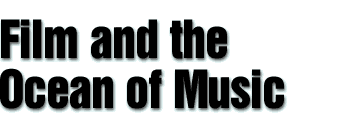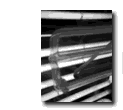|
 |
||
| A composer sails towards new music film forms. By Robert Robertson |
By chance (or perhaps by affinity) I've moved gradually and unsuspectingly from the world of opera to the music-film work. I wasn't composing 19th century-style opera (like many being written today) but new forms with a complete unity of music, theatre and dance. These works involve singers whose voices have not had their unique qualities ironed out of existence by standard operatic training: operas like The Kingdom, The Cathars, and the dance opera Empedocles.
In 1981 I drew the libretto for The Kingdom from the Cuban writer Alejo Carpentier's novel The Kingdom of This World, his account of the tumultuous transformation of the French colony of Saint Domingue into the Independent Black Republic of Haiti. The Haitian Revolution was fuelled by religious ceremonies where music and dance were (and are) an integral part of daily life. I couldn't look to earlier models of European opera to structure the four act work, as all the combinations of music, theatre and dance in The Kingdom take place in real time. Unlike in previous operas (and musicals) the theatrical pace isn't slowed down by the music, but is maintained by it. The spine of the opera, the libretto, was inspired by Eisenstein's film scenarios, and so it was natural for me to structure it according to what became one of his key cinematic ideas: the montage of attractions. Eisenstein had derived his idea from the circus, a theatrical form which exists in real time, and where the music sets the pace, heightening the contrasts between each succeeding attraction. So the opera The Kingdom functions like a film in the theatre. However, when watching the film of the Amsterdam production of The Kingdom, it's clear that it's an opera and not a film, as theatrical pace, even when it functions in real time, isn't as compressed and fast as cinematic time.
Financially and logistically the production of The Kingdom was a major undertaking. Funded by the Dutch government, a company had to be created for it as there was no existing group with the needed mix of Caribbean and European performers. There were over sixty rehearsals over a four month period and the fifteen performances in Amsterdam were all sold out. At this time (1983-84) there was money available for such ways of working. Subsequently The Kingdom toured The Netherlands, and DNA was born, a music/theatre/dance company was created from the cast by the late Rufus Collins who with Co-Director Henk Tjon, had directed the first production of the opera. DNA is now also a school for performers for music/theatre/dance works, and a memorial tribute to Rufus Collins is planned at the Oval House Theatre in London in November.
The montage of attractions was also used to structure The Cathars, an opera on a similar scale about the Albigensian crusades (which had to be produced in a modified form, due to shortage of sufficient funding in the UK eleven years later) and The Rabelaisiad, for seven actors creating multiple voices, performed at the Institut Français in London in 1993 and will be presented at the University of Paris 7 at the international Interface conference in June. Based on my translation work is based on writings by the illustrious unknown François Rabelais, I made line drawings in biro for it - these projected by means of cross-fading slides. Realised on a decidedly low budget, the British actors (who excelled in the farce tradition) achieved virtuoso performances after only one read-through and one rehearsal, a fact which astonished the audience at the rabelaisian party afterwards.
Paradoxically, lack of funding was a key factor in the transition to film, a medium traditionally thought to be more expensive than any other...
Full article published in Filmwaves - Issue 7, Spring 1999. Subscribe now!
